Keeping hybrid working secure and staying in control
Making the most of digital workspace transformation – Part 2
As widespread digital workspace transformation continues to progress, and the working standards of individuals and businesses continues to evolve, keeping pace is increasingly important. If a business is behind the curve, it becomes ever more difficult to attract and retain talent. But with the desire for remote and flexible working being higher than ever, how can you meet this need without jeopardising your business security and continuity?
XMA can help you with this. In a previous blog, we looked at how we can use an effective planning and deployment strategy to help your business embrace new ways of working. In this second blog, we’ll be looking into the ways we can help you keep control of your network, without ever laying your hands on the devices your team uses.
When people work remotely, it’s likely that the range of devices available to them will go up. For example, some people might have a powerful PC at home, while others might prefer to work from a personal tablet or phone occasionally. While this boost to staff convenience is hard to ignore, it does raise several major security concerns. As these devices are outside your management control, they could be an ideal access point for hackers and viruses. As a result, many businesses are choosing to restrict access to managed devices only.
Whether you choose to allow a varied range of devices to use your network, or supply specific machines to each member of your team, we can help. Sophisticated endpoint and access management systems, enabled by Windows 10 technology, allow you to retain control while enabling an enormous level of flexibility for your teams. This will let you simplify automated provisioning, configuration management, and software updates for every single device that uses your network, regardless of operating system.
Device management is just part of the battle. Alongside close and customisable control over access, based on your specific needs and wishes, we’ll also develop a robust and personalised data security and risk management policy. This will consider the sensitivity of your data, how much access is required for each individual, and much more.
Using the latest software and zero-trust techniques from Microsoft, including Windows 10 Authenticator for two-factor authentication, we can start to create an environment that enables digital workspace transformation, without jeopardising security for the sake of access.
Enabling cultural change is naturally important for a business, especially right now, but doing it in a way that’s sensible, safe and suitable for you is incredibly important. It’s not something to be rushed, you need to pick the right path for you. Our team will help you to pick the right path, and use the best technology from Microsoft, along with other major vendor partners, to make it a reality.
We’ll be continuing our blog series on digital transformation in the weeks to come, so keep an eye out for part three. If you’ve not read the first part, or would like a reminder, you can find it here
How did the Covid-19 lockdown impact sustainability?
The conversation around the shift to remote working is constantly ongoing, and we have all seen first-hand the positive impacts on businesses. This includes anything from improved collaboration and productivity, through to better mental health and wellbeing. Technology has been a key enabler in supporting the move to remote working.
Technology adopted during lockdown to enable employees to work remotely has shaped not just organisations during lockdown, but strategic business planning moving forward. We have already seen announcements from large enterprise technology organisations, shifting their working model to remote, either entirely or in part.
The productivity benefits of working from home centre around the loss of the need to commute. With the average person’s work commute at 60 minutes each way, this has saved on average a staggering 10 hours per week spent mostly in the car, on the train or bus. As a result of this, the European Environment Agency’s data confirms large decreases in air pollutant concentrations, of nitrogen dioxide (NO2) concentrations, largely due to reduced traffic and other activities, especially in major cities under lockdown measures.
Reductions of around half have been seen in some locations, for example:
- In Milan, average concentrations of NO2 for the past month have been at least 24 % lower than the month prior. The average concentration during the week of 16-22 March was 21 % lower than for the same week in 2019.
- In Rome, average NO2 concentrations for the past four weeks were 26-35 % lower than for the same weeks in 2019.
- In Barcelona, average NO2 levels went down by 40 % from one week to the next. Compared with the same week in 2019, the reduction was 55 %.
- In Madrid, average NO2 levels went down by 56 % from one week to the next. Compared with the same week in 2019, the reduction was 41 %.
- In Lisbon, average NO2 levels went down by 40 % from one week to the next. Compared with the same week in 2019, the reduction was 51 %.
(European Environment Agency, 2020).
After achieving and analysing this reduction in pollution, will the Covid-19 lockdown result in real progress to tackle climate change?
Whilst addressing long-term air quality problems requires ambitious policies and forward-looking investments, the Covid-19 lockdown demonstrated the capability we must vastly reduce our emissions. When the noise of airplanes and traffic was gone, it helped us understand and have empathy for the effects of climate change on future generations. The lockdown also demonstrated to employers that employees can effectively work from anywhere with best placed technology, and in turn contribute toward a greener and more sustainable future.
Is your business set up for remote working?
XMA have been supporting businesses throughout Covid-19 to achieve efficient digital workspaces. Get in touch to discuss your Digital Workspace now.
Reference: European Environment Agency (2020). Air Pollution. Available at: https://www.eea.europa.eu/highlights/air-pollution-goes-down-as [Accessed: 24.08.2020]
Windows 10 out of 10
I hope everyone is safe and well during lockdown and people are still finding fun ways to stay active and social. Like many people I’ve been having regular quizzes online with friends, often ending up in ‘JD Wetherzooms’ for a few drinks. I recently hosted a Britain’s Got Talent spoof on Teams and people were impressed at how some of the features were in the free version of Teams and how well it integrated with Windows 10 features!
I’ve been a windows 10 user for so long I’ve almost forgotten what Windows 7 looks like for those feeling nostalgic here you go..
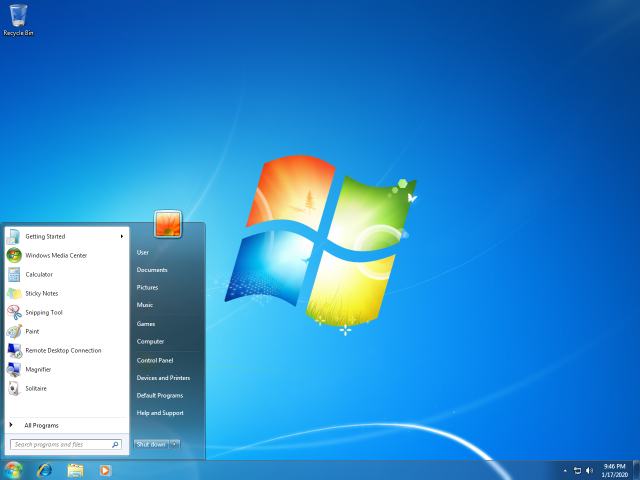
With the evergreen Window 10 OS features are rolled out so regularly that often they can be missed! I’ve handpicked some of the top ways I have been more collaborative and productive during current COVID remote working!
Let us begin at the start…
Just like organising your apps on your phone, or bookmarking your favourites within your internet browser, by customising you Start Menu you will have you go to applications and documents just one click away!
Pin apps to the Start menu for quick access to what’s important by selecting Start> press and hold (or right-click) the app you want to pin > Pin to Start.
Treat your start menu to a spring clean by unpinning the apps you don’t need to make it less cluttered!
To get really organised you can actually create your own Start Menu folders.
Drag one tile on top of another to make a folder, then drag more tiles into it. To open the folder, just select it.
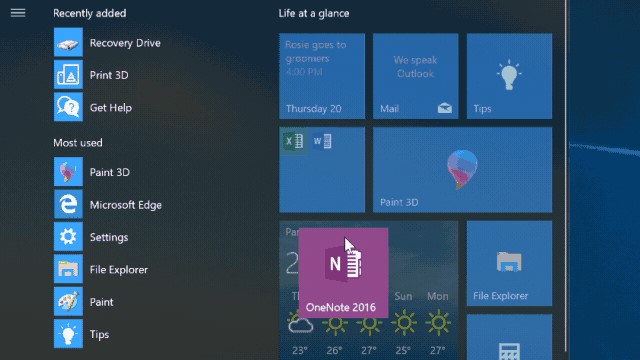
Share the workload!
Most people are aware of OneDrive and being able to save and share documents from their own cloud hosted folders. Once a document is in your OneDrive if you want to share the document for joint working you can simply do that via right-clicking the file and selecting More OneDrive Sharing Options.
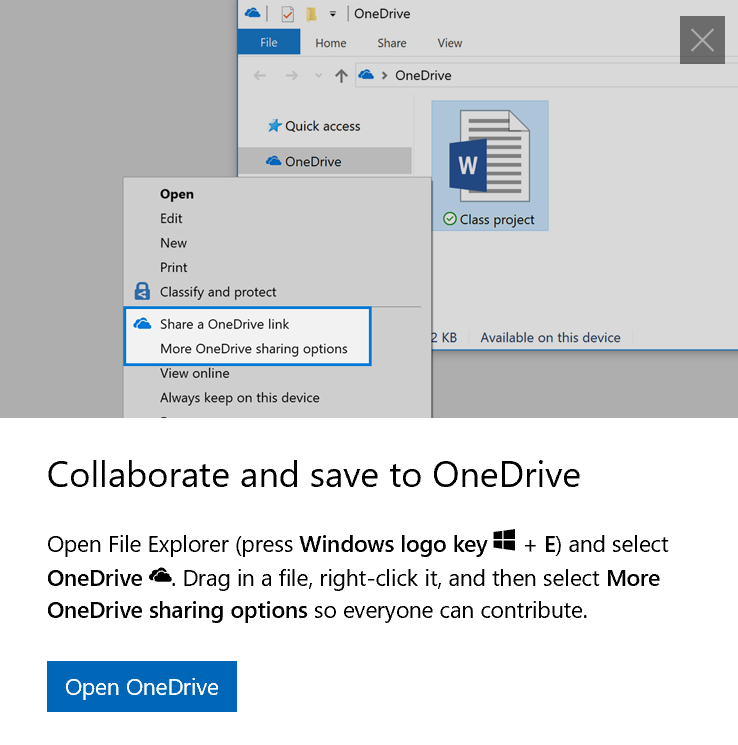
To edit this document in real time with colleagues, once opening the document you can select Share, enter the email address of the people to share with and select Send. Now the file is shared with everyone on your list.
Whilst editing each user will be assigned a coloured flag to illustrate where they are in the document. This saves time emailing around the document and loosing track of versions, and allows maximum productivity when on a team call.
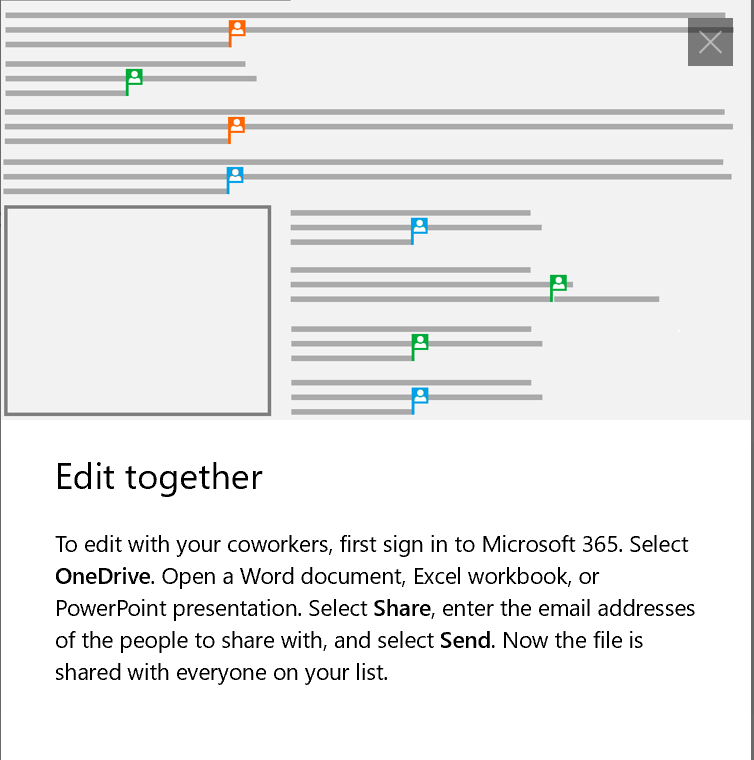
If you are not on voice call, you can still chat with colleague within the shared document. When editing a shared Microsoft Word document if you select the picture of someone who is editing at the shame time, you can hit the Chat.
Many screens make light work…
You may have had a dual screen set up in your office or an external monitor that would allow you to view multiple applications at the same time. A prime example for me is switching between a Excel spreadsheet price file and XMA quoting system. Windows 10 provide a handy way of allowing you to snap applications side by side. If you select any open window, then drag and bounce it against the side of your screen. All other windows you have open will appear on the opposite side. Select a window to have it fill the open space.
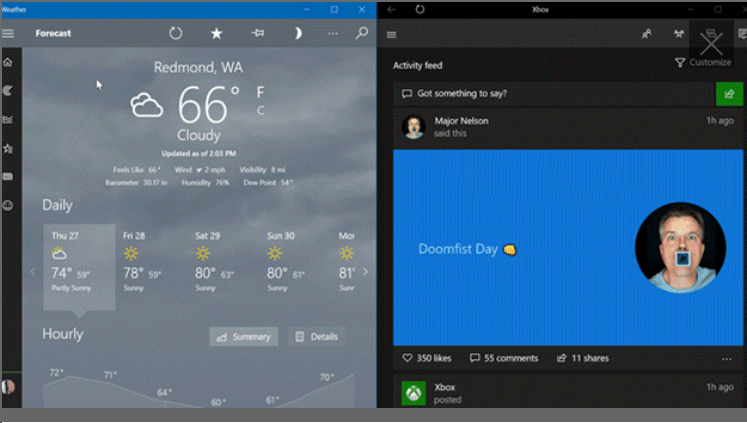
If your finding yourself spending more time looking at your phone screen as well, you can actually use the phone directly from your Windows 10 machine. The Your Phone App allows you to link your android phone to your device to respond to text, share photos, make calls and more. iPhone users can also use the all-in-one Office app to stay productive wherever you are. Ideal for when you want to get some fresh air and sit in the garden!
Saving your bacon!
Never underestimate the pain of losing documents and folders if your PC breaks when your darling daughter accidentally knocks a whole glass of orange juice over your keyboard!
Thankfully like me, you can automatically back up document, picture and desktop folders to OneDrive so they are protected whatever happens to your PC!
On the right side of the taskbar, select OneDrive > More > Setting and on the AutoSave tab, select Update Folders and specify which folders you’d like to keep automatically synced.
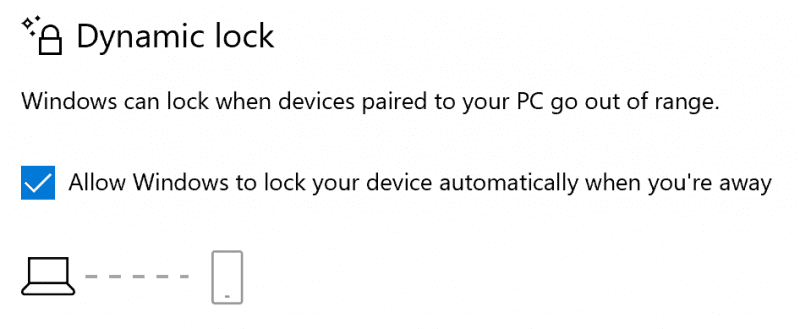
To prevent the offspring from deleting my work when I’ve left my laptop unattended whilst getting a cuppa I’ve also setup Automatic locking on my PC.
You can use Dynamic Lock setting to lock your PC once a paired Bluetooth device (possibly your headset or phone) leaves the proximity around your PC.
Under the Start menu go to Settings > Accounts > Sign-in options. Select the check box under Dynamic lock, and then take your device and walk away, safe in the knowledge that you PC screen is locked!
Oooo work-friends…
Keep your favourite people nearby… by using the People app you can keep important contacts right on your taskbar, so they’re always within reach when you want to chat.
People pulls in contact info from apps like Teams and Mail. Once you’ve connected those apps, use People to find your favourites and pin them to the taskbar for easy access.
Pin a contact to the taskbar
Easily get in touch with your favourite contacts. Select People > Find and pin contacts, then pick who you want to pin! Obviously, our marketing team are pinned in mine! ?

I hope that you’ve found the above features interesting and useful and honestly this is just the scratching the surface [no pun intended] of ways that windows 10 can help. For more tips and tricks please check out Microsoft’s Windows 10 page here
On the 5th of June I am running a webinar with Dan Boyles from Microsoft to discuss some of our favourite features in Windows 10 and how they are making our remote working lives easier. You can view the webinar here
In the meantime if you have any questions on Microsoft licensing, products or feature please drop me an email on James.Thorogood@xma.co.uk
Stay safe. Stay connected.
All the best,
James
Cloud Physics: An analytics-driven approach to managing infrastructure
A New Approach
In today’s world of software-defined datacenters, infrastructure is increasingly complex and change is constant. The potential for change-related risk to applications is greater than ever before. In spite of the abundance of tools available, IT administrators lack the ability – and time – to study all the known or unknown configuration issues in their vSphere infrastructure. They struggle to understand whether changes – intended or accidental – result in smoldering performance and availability issues waiting to ignite.
Further, when things go wrong, there’s an inability to replay the changes over time to correlate events or trends that caused the current problem. This creates a significant drag on administrator effectiveness especially as they are thrown into firefighting mode to minimize the impact of unexpected application disruption and related costs.
The goal of CloudPhysics is to provide organisations with an analytics-driven approach to managing infrastructure that enables administrators to preempt emerging hazards and gives them the confidence to act boldly to reduce risk and waste in their vSphere environments.
To learn more , please fill in your details below to receive a free copy of the CloudPhysics whitepaper.
Everything you need to know about dHCI…
XMA’s Infrastructure Solutions Team are seeing a growing interest in dHCI from HPE.
XMA Solutions Director for Infrastructure – Jen Norman – and her team of Datacentre Architects take a closer look..
We’ve been designing and installing Hyperconverged Infrastructure solutions for some time now, and between Myself and my Datacentre team we have over (*cough) 115 years (*ahem) engineering experience between us. So when HPE came to us with a disaggregated hyperconverged infrastructure solution last year, apart from repeating the name several times over to ourselves, we got onboard and got involved. Now we are privileged to have completed our first dHCI live production solution deployments earlier this year.
What could you be facing?
So maybe your VMware system is running out of storage capacity, your servers are dated and you can’t upgrade to run the latest versions.
Ok. Well you’ve done some research and investigation. You want a hyperconverged replacement where you can run concurrent workloads, and like the idea of being able to scale out storage or compute separately. BUT it would be great if you could get this delivered, supported and managed as a single product.
What else might you need?
Well as standard, you want a storage system that has options for encryption, compression and deduplication, application consistent snapshots and advanced replication (ether synchronous or asynchronous) with near all-flash speed and sub-ms latency for always-on apps. That’s a given.
Definitely VMware clusters running on the latest compatible server hardware and block level storage.
A complete turnkey solution? One that is monitored from the application to the storage, proactive alerting and with the ability to predict and prevent infrastructure problems before they happen.
Nothing less than a system designed for 99.9999% availability – no single point of failure, hardware redundancies with the ability to tolerate 3 simultaneous drive failures!
And you’re pretty sure that Procurement will want the choice on finance options – including future proofing, cloud like financing, with integrated support.
Then you definitely need a HPE disaggregated hyperconverged solution (dHCI)
And you are not alone. Since its inception in 2019 we have seen successful installations in Local Government and Education, with interest and opportunities growing in the Corporate, Commercial Enterprise and Healthcare sectors.
It’s a winning combination
You take the power and performance of the HPE Nimble Storage array, with its self-managing flash storage.
Add industry-leading HPE ProLiant Servers, include HPE storage switches, and deploy VMware vSphere.
Then this is all preconfigured as a turnkey solution!
Then automate with full-stack intelligence and policy-based automation for VM-centric management.
But here’s the best bit……
Add the power of HPE InfoSight over all this, and you have full-stack predictive analytics and support automation working for you that predicts and prevents issues. Infosight auto-routes any complex issue directly to L3 HPE Nimble support.
HPE have streamlined their support portfolio to offer four service levels that are easier to understand, easier to align to business needs which gives you visibility into IT assets and support status from anywhere.
You can flexibility and independently grow compute and/or storage – adding new dHCI compatible storage and/or servers when required – for scale-out upgrades that are non-disruptive and transparent to applications.
Eliminate over provisioning and add only the resources when needed. The Timeless Storage means no worries today or tomorrow with all-inclusive software licensing, flat support pricing, no forklift upgrades, and an option to receive a free faster controller upgrade after three years with Timeless Storage.
And, if you’re reading this thinking ‘well this sounds great but I’ve still got Gen9 (or 10) Proliant servers that are in warranty and I don’t want to replace them yet’.. Well HPE read your mind, (just kidding, they leave that to your home speaker system and asked Alexa what you thought), and have designed the solution so you can use the existing compute you already have in place, add a Nimble array and the dHCI software allowing you to convert everything in to a dHCI solution!
Is this Complex?
HPE Nimble storage arrays can be installed and be up and running in half a day requiring no external tools or software – we have completed installations where the HPE Nimble arrays that have been physically installed, configured, integrated and have test VMs running within hours ready for User Acceptance Testing (UAT). They can be All-Flash (AF) or Adaptive Flash (HF) for mixed, mainstream workloads, where cost-efficient flash performance is important. It is a Secondary Flash array for backup and DR while allowing you to put your backup data to work.
For the compute you have the HPE ProLiant Gen10 DL360 a performance driven dense server or DL380 for performance and expandability. These servers deliver security, agility and flexibility without compromise – with the knowledge that you can confidently deploy for virtualisation.
These are completed with a choice of Ethernet HPE storage switches to meet your budget and installation size.
Root Cause…. Could it be the network? A server fault or a storage fault?
Once installed HPE InfoSight can help you stop spending days searching for a root cause deep in your hybrid environment. Every second, HPE InfoSight collects and analyses data from more than 100,000 systems worldwide, and uses that intelligence to make every system smarter and more self-sufficient. The result? HPE InfoSight predicts and automatically resolves 86% of customer issues.
Where to go for more information:
HPE dHCI
Why choose XMA?
We are an HPE Platinum partner and have trained and Certified HPE sales and engineers with Master Accredited Solutions Experts (top-level credential validates technical skills) with experience in building and sizing advanced enterprise systems. Continually staying up to date with the latest technology updates, strategies and programs. One of our core values is “customer focus”. We put our customers at the heart of everything we do. We don’t just provide technology we provide solutions.
Written by Jennifer Norman, Solutions Director for Infrastructure
Say ”Goodbye” to Windows Server 2008
Say “hello” to a secure, simple, cloud-ready future
Modernise with the latest versions of Windows Server on HPE Gen10 and benefit from improved security, greater efficiency, and access to the cloud.
Windows Server 2008 went end-of-support January 14th, 2020.
Windows Server 2008 is an operating system produced by Microsoft. In the past, if you had a problem with your server, either you, your IT partner, or your software vendor had the ability to reach out to Microsoft to get:
- Technical support
- Help troubleshooting issues
- Patches or updates
Microsoft will no longer provide this support.
If your business runs software on the Windows Server 2008 operating system, neither you, nor your IT vendors, IT service providers, or custom/third-party software application developers will be able to contact Microsoft for help even if the issue originates in Windows Server 2008.
Upgrade to Windows Server 2019 today with Windows Server on HPE Gen10
The Benefits
In addition to cybercrime protection, new systems are significantly more efficient. With Windows Server 2008, virtual machines consume so much CPU and memory that only a small number of VMs can run on each physical server. With modern Windows Server technology, it’s possible to run hundreds or thousands of containers on each server. Fewer servers = lower costs and less complexity.
Old servers play a large role in rising IT costs because they drive up the #1 cost issue for most data centers: software license and support fees. Moving to the latest HPE Gen10 servers will help control this significant expense. Since most software is licensed according to the number of processor cores:
faster servers = fewer cores = lower software license costs.
Download our InfoGraphic to find out more
Migrate straight to the cloud?
Microsoft will offer extended security updates for customers who migrate their legacy applications to the Azure cloud and run them on virtual machines. Is that the best solution for you?
Migrating your entire legacy environment to run in virtual machines in the public cloud still leaves you with outdated applications on an OS that loses support as soon as you leave Azure. And VMs in the cloud require extensive ongoing management for many of the features that are automated in cloud-based applications, including configuration sizing, securing, patching, and maintaining. A migration of Windows Server 2008 to VMs in the cloud is a short-term fix that will need to be resolved for your business to truly benefit and move forward.
The better alternative
When a legacy Windows Server 2008 environment is modernised on HPE Gen10 Servers with a current version of Windows Server, you get the added security against cybercrime, the efficiency of cost-saving technologies, and the benefits of a hybrid cloud platform. Exciting HPE products like Synergy, SimpliVity, and the Apollo System for AI and Deep Learning provide powerful tools so that you can successfully address the IT challenges that were never imagined back in 2008. It’s time to move forward.
Contact us today to find out more about which solution is best for your business
Technology is transforming the healthcare industry
Technology is transforming the healthcare industry. It is now possible to provide a better experience to your patients and practitioners by modernising your healthcare environment with modern technology.
Widespread adoption of emerging technologies is changing the way medicine works; however, future-proofing hospitals remains a concern. Healthcare providers often face the challenge to cope with more patients, adapt to new technologies and provide smart facilities & services. To meet this concern, healthcare providers need modern systems. They require robust infrastructure solutions to improve efficiency & help the clinicians advance the quality of patient care. With HPE’s ultimate infrastructure solution, HPE Synergy, healthcare leaders can deliver a superior Virtual Client Compute experience that allows medical providers to enjoy higher availability of GPU intensive applications.
Healthcare providers can now access the ultimate flexibility to maintain a variety of workloads on a single platform, as well as scale to meet greater demand during seasons of increased usage. HPE Synergy has been thoroughly designed to compose and recompose assets in a matter of minutes—enabling new levels of speed and efficiency.
HPE Synergy provides a foundation of innovative security features that goes beyond perimeter protection—arming your systems to prevent, detect, and recover from threats. You can enjoy a seamless, consistent experience across devices, even as caregivers move to different rooms within a facility. With Synergy, we can virtualise the OEM applications and the delivery of the GPUs to the applications.
Coupled with HPE Pointnext services, Proactive care support provides both reactive and proactive service elements for your synergy devices and systems and helping you focus on your key priorities. Designed to help reduce problems from occurring and giving you a rapid response when they do occur. With HPE proactive care, you will get enhanced call experience with an assigned Technical Support Specialist who manages your case from start to finish and rapid access to technical experts to help resolve issues quickly. Proactive issue prevention with tailored reports for firmware/software revision management, proactive scan (health check), and incident trend reports. This will Free up IT teams from day to day maintenance and helps your team to protectively manage firmware/software revisions and other aspects of system health.
The Healthcare industry needs an infrastructure that is flexible enough to maintain a variety of workloads and scale with the seasons of increased usage. Moving to composable architecture can provide healthcare leaders with the ultimate flexibility to allocate a variety of workloads on a single platform and recompose those assets in minutes. Together with a streamlined management interface, healthcare providers can now also enjoy a greatly simplified management experience.
To learn more about HPE Synergy into Healthcare, download our brochure
XMA in Healthcare
We’re passionate about delivering an outstanding customer experience and are trusted by some of the largest Public Sector organisations in the UK. With Government initiatives such as the NHS Infrastructure Maturity Model (NIMM) continuing to drive transformation across IT infrastructure, we align our knowledge and experience to deliver sustainable solutions which address the need for good governance.
As a long-term supplier to the NHS and an accredited supplier under the Crown Commercial Service, we recognise the potential to use technology to create efficiencies and improvements to patient care across all GP practices, CCGs, CSUs and local health economies. By combining our understanding of the NHS IT market, IT partner alliances and our national service and delivery model, we help organisations make the shift towards digitised healthcare.
Covid-19 – Partner Updates
Like all businesses, XMA are concerned about the recent Covid-19 outbreak.
After the announcement by the Prime minister on 12th March we are continuing to follow government advice closely and are primarily focused on ensuring the safety of our staff, customers and suppliers.
The company has a business continuity plan in the event of any significant disruption and will endeavour to keep as near to normal levels of service if a period of quarantine is imposed by the government. Clearly, if our warehouses are closed, this will be more disruptive. We will post updates regularly on our website as the situation alters.
We work with a number of technology partners as do our customers and have consolidated links to our partners Covid-19 messaging in one location. Many of them working to assist their customers where they can with their relevant technologies in areas such as “how-to” webinars, providing software at no or reduced cost – mainly around remote working as well as general updates on their business during this time.
Please see below links to our Vendor Partner updates:
Cisco
Cisco Webex
Dell
VMware
Citrix
Microsoft
HPE
Nutanix
Rubrik
Palo Alto
Trend Micro
HP
Lenovo
Google for Education
If you have any questions or concerns around your Infrastructure, please get in touch with your XMA Account Manager or contact us on the form below.
To read our response to the COVID-19, please read here
How can Microsoft help with Covid-19?
We all know that technology is going to play a pivotal role in reducing the impact of COVID-19 on people and organisations, including helping them stay productive at work when they’re not able to be there in person. However, lots of businesses, as well as education and public sector organisations, are not geared to sudden mass home working.
For our customers at XMA I wanted to update you as to how you can work remotely without sacrificing collaboration, productivity or security.
Microsoft launched an interactive map that allows visitors to click on the country to see the specific number of cases of COVID-19 based on data from the World Health Organization (WHO); the US Centers for Disease Control and Prevention (CDC); and the European Centre for Disease Prevention and Control (ECDC).
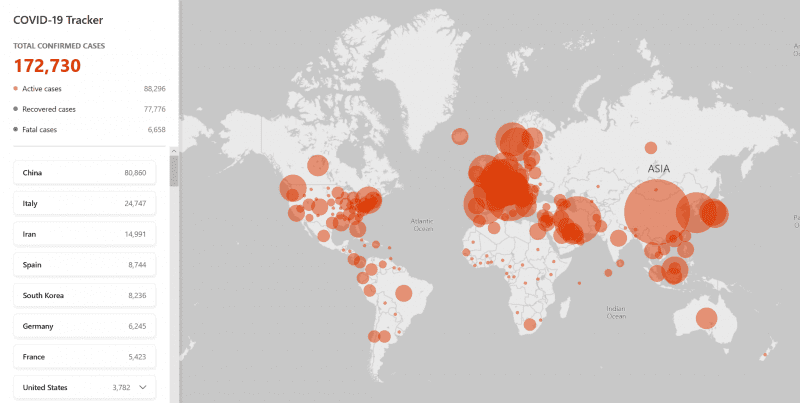
View the interactive covid map here
Whilst it is scary to see this data outlined on a heatmap, I’m pleased to report that this website is not the only way that Microsoft are supporting in the COVID-19 crisis.
JP Courtois [Microsoft’s executive vice president and president of Microsoft global sales, marketing and operations] announced that Microsoft are making their paid for collaboration tool, Microsoft Teams, free for six months to help organisations deal with the demand of end users needing to work from home.
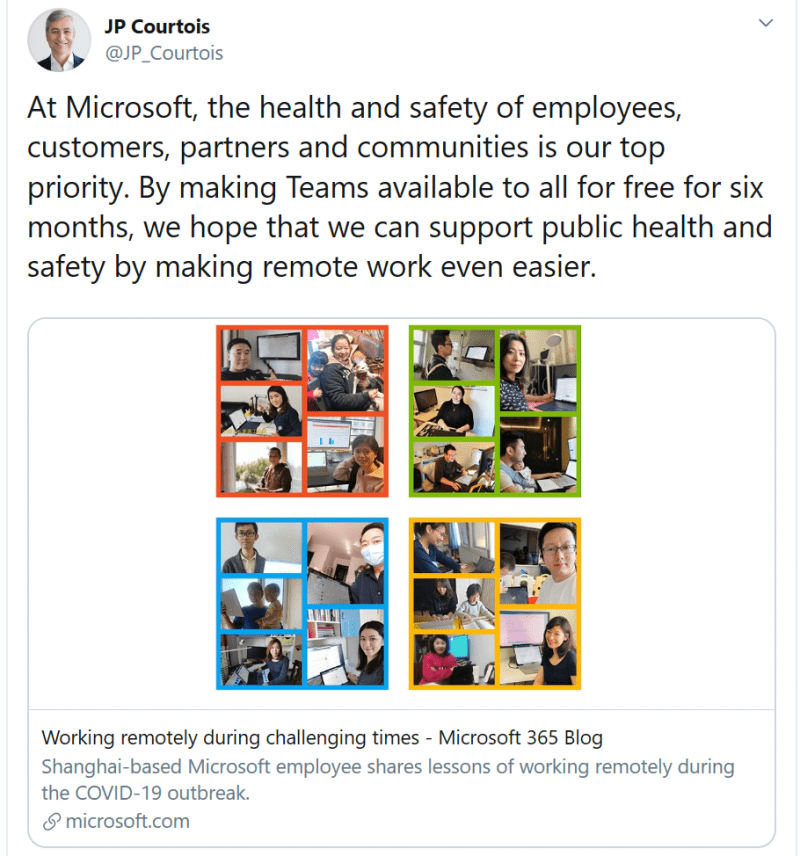
The Teams trial is part of a new Office 365 trial for enterprises (Office 365 E1) which includes full meeting, collaboration and workflow capabilities.
Read Microsoft’s full statement here
Microsoft rolled out a new update on March 10 which lifted restrictions on how many users can be part of a team in the free version of Teams. The newly released features include being able to set up Office on personal devices such as phones and tablets; 1TB of cloud storage; enterprise video-sharing service; and being able host online video conferences.
For me the key obvious benefits of this are the online meetings, increased file storage and Office Suite on a personal device.
- You will be able to host online meetings with audio, HD video, and web conferencing. Even being able to present ‘Broadcast meetings’ which will allow up to 10,000 people join with just a web browser. This can be done on almost any device – perfect for large, companywide, conferences or events.
- With OneDrive for Business each user has 1 TB of personal cloud storage that can be accessed from anywhere, on any device. This means that you can securely save the documents that you work on at home and share with others inside and outside your organization, whilst being in control of who can see and edit each file. You could then sync these documents when you get back into your place of work with your local drives.
- Installing the native Office suite of products such as Word, Excel and PowerPoint will enable most workers to continue being productive especially if their own organisation can not afford to provide them with company owned hardware or the licences.
At XMA we were already regularly seeing the benefits of Teams but now with imposed travel reductions it is becoming a go to solution. Being well verse in the Microsoft Eco-structure internally as well as via our consultants, if you require any assistance on getting your trial setup, please let us know and we are of course happy to help.
In addition to this extended 6 month trial there are also specific ways that Azure AD can help enable remote access to work resources.
Please check out the Microsoft blog
At XMA we want to help our customers in this time of need. So any support you require from your Account Manager, please let them know. For the more specific items I have covered here today, please feel free to reach out and contact me directly.
In summary stay safe, travel less, collaborate more.
James
James.Thorogood@xma.co.uk
CSP Software Business Manager
2020 Tech Predictions
1919, 2020, 2121
Unless we technologically advance rather ferociously in the coming years, this is the last time we will see a double figure year in our lifetime, so it’s pretty special!
An iconic year for us all to really make an impact.
Let’s jump straight into our technology predictions for 2020: sustainable innovation, experiencing technology, time limits, specialised talent, and transhumanism.
Sustainable Innovation
Change is upon us, effective change is imminent.
Being sustainable is at the core of every business. As businesses, we want to be seen making positive changes, but how far are we all actually going to make an impact? Is there any evidence to analyse? Any substance behind the claims?
We can expect to see greater investments in reuse and recycling for closed-loop innovation and expect to say goodbye to the days of bulky hardware, as just like the nano SIM, hardware are becoming smaller and more efficient and we will be more reliant on the Cloud. We can expect more organisations to source new sustainable materials for example being built with recycled and reclaimed goods.
In 2018, HP used 21,250 tonnes of recycled plastic in HP products – including 8,360 tonnes in their personal systems (a 3.5% increase from 2017); 4,790 tonnes in their printers (a 280% increase from 2017); and more than 8,000 tonnes in their ink and toner cartridges.
“As of September 2019, HP sourced about 450 tonnes of ocean-bound plastic bottles (equal to roughly 35 million bottles) that are recycled and used to make Original HP ink cartridges and hardware, including the HP EliteDisplay E273d Docking Monitor (announced in June 2019) – the world’s first display manufactured using ocean plastic. Display manufactured with 5% ocean bound plastic materials by weight, the equivalent of more than three 16 oz. recycled plastic water bottles.” (HP, 2019).
So an absolute #GameChanger is the HP Elite Dragonfly, after launching in September 2019, this beautiful, slimline device has been the talk of Tech Town. Not only is the HP Dragonfly the world’s most lightweight 13” laptop, it is also the world’s first notebook with ocean-bound plastics, including 5% in its speaker, and has started a standing-ovation-worthy cybersecurity revolution…
The motherboard is where the magic happens, but with the Dragonfly, it’s more than magic, it’s where their intelligence driven superpowers are challenged. Sure Sense, required with Windows 10, is trained to seek and analyse trends in Malware. Unlike Norton for example, which detects known malware, Sure Sense looks for codes and changes in malware that Norton would not be able to spot. This is next level. This is now. This is the answer to your cybersecurity concerns.
We predict that the HP Dragonfly will have a snowball effect on other organisations and we will see more plans and launches of devices which use sustainable materials in their products. It’s all part of the sustainability grape vine. Find out why this is so important to us here.
Technology Experience – learning how to use technology more creatively to go the extra mile.
We predict that 2020 will create a new wave of fun for technology users. Consumers will use their devices and software to a fuller extent, producing a richer experience. Technology Education will make a breakthrough from younger ages through to adults and a better understanding of technology and it’s possibilities will be explored. Technology consumers will move forward and develop more creatively – beginning to safely experiment and enjoy the dormant or ‘unknown’ features to a fuller extent.
Time limits Apps/Personal
After studies suggest social media is addictive to younger consumers, we predict apps like Instagram and Facebook will set up ‘recommended screen time’ to present themselves as transparent and responsible media owners. At first, this could be promoted via a push notification, followed by a hideable banner on the homepage if not actioned by the user.
As well as apps encouraging this, we predict that tech users will start taking more of an active role to their technology intake and allocate certain time slots for apps.
As a side note, media giant Instagram appears to have the user at the forefront of their minds. Recently after a trial period in the UK, Instagram removed the amount of likes on photos to other users, only the photo owner can see the total number of likes; however this does not stop savvy users counting the profiles that liked it. The move was designed to promote positive well-being and to downplay the importance of users receiving ‘social validation’ on their posts after concerns of growing online anxiety, and instead to shift focus to the content they freely want to share.
Training for Specialised Talent
As I’m sure you’re aware, ICT is a rapidly growing industry, and after every layer is peeled, another 500 appear. Because of this, there is talent in special areas, we have seen the Facebook Content Manager and Social Media Community Manager, but we can expect to see wild job titles entering the mix. Perhaps Linkedin Automated Message Developer, Instagram Beauty Hashtag Expert, or Website Header Transition Engineer.
Technology has a major role to play in learning and in preparing students for the world and careers they’ll be responsible for in the future – a future where 65% of jobs they will apply for do not exist today. (World Economic Forum, “The Future of Jobs: Employment, Skills and Workforce Strategy for the Fourth Industrial Revolution,” January 2016).
In May 2017, BBC Sounds podcast covered this and even though this circulated figure is debatable, it creates a thought whirlwind… will technology in education create more doors to open with more space to explore? How is technology training in schools being implemented effectively to prepare for these changes? If you’re interested in finding out some more, sign up to one of our Google Interactive Learning Experiences at BETT 2020 here.
Transhumanism
How would you feel about opening your front door by the swish of your index finger? What about picking up loose change from behind the sofa with a magnetic middle finger? Would you find it helpful having a chip in your wrist which is full of your medical information?
Introducing… Transhumanism.
The belief or theory that the human race can evolve beyond its current physical and mental limitations, especially by means of science and technology.
When we think of transhumanism and technological developments into our bodies, we could think of a certain alien invader – cyberhumans. And hello 2020, we can liken this concept to BBC’s hit drama ‘Years and Years’, where student Bethany is obsessed with transhumanism and the culture of integrating humans with technology. If you haven’t seen it yet, it is definitely worth a watch to examine life in possibility.
‘I’m going to escape and become digital’.
Granted, talk of removing the brain with all your life’s information and storing it into the Cloud is a tad extreme, however that is transhumanism in its ultimate form. Saying this, Winter Mraz, 31, labelled as a ‘Tech Geek’, with a degree in Games Modelling, Animation, and Effects, began augmenting herself after a car crash in the United States.
With ‘bionic’ implants inserted around her body, she argues over popular contraceptive implants, presenting conflicting ideas of ‘what’s the difference between a contraceptive implant and a microchip?’
Working as an engineer, she said her magnetic and data-fuelled implants allow her to sense electromagnetic fields and help avoid touching live wires at work.
Some argue that either through genetics or artificial intelligence, humans will be able to create a human being that is far superior to what we are now. From robotic hearts which don’t stop ticking, to saying ‘see ya’ to Rapid Wrinkle Repair cream and welcoming in genetic enhancements to make us not age or stay young forever, and let’s not forget about the development of bionic eyes that immediately download TV shows.
Overall, the concept of transhumanism is to collaborate humans and technology to make us more functional beings which live longer and more efficiently.
Will humans be free thinking, decision making entities in the Cloud?
Will we upload different versions of ourselves?
What if our Cloud personas are hacked? Rewind to this iconic episode of Doctor Who and The Rise of The Cybermen.
Is this a work of art? Or work for reversal?













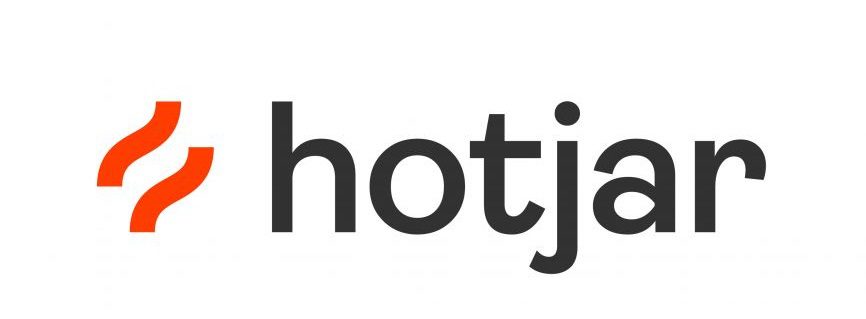 Monitoring by Hotjar
Monitoring by Hotjar